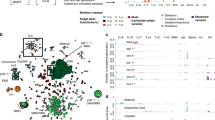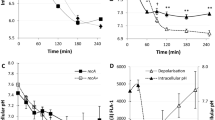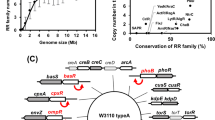Abstract
ESCHERICHIA COLI can acquire resistance to the lethal and mutagenic effects of alkylating agents such as N-methyl-N′-nitro-nitrosoguanidine (MNNG)1. We have called this the adaptive response and have shown that it is distinct from previously described forms of DNA repair, including the inducible error-prone pathway2,3. The induction of a similar response has recently been demonstrated independently in the liver cells of animals fed dimethylnitrosamine (DMN)4. The phenomenon is therefore apparently widespread and may conceivably protect us from mutagenesis and carcinogenesis induced by low levels of nitrosamines. The main mutagenic lesion produced by agents like MNNG and DMN is probably O6-methylguanine (O6-MeG)5, which can be read as adenine during DNA replication6 and transcription7; certainly, most of the mutations produced by MNNG are GC to AT transitions8. Therefore, it was not surprising to find that adapted bacteria contain less O6-MeG after a challenge dose of 3H-MNNG than do non-adapted bacteria9. However, the response seemed to have two distinct components, which we can call the fast and the slow reactions. Immediately after a 2-min exposure to 3H-MNNG the adapted bacteria contain less O6-MeG, as if some fast reaction were protecting them from accumulating alkylation at the O6 positions; there is, however, a limit to the capacity of this part of the response, and at higher concentrations of 3H-MNNG (or after longer periods of exposure) the adapted bacteria start to accumulate O6-MeG (and mutations) at the same rate as the non-adapted bacteria. This suggests that the molecules which carry out the fast reaction are used up during their interaction with O6-MeG (that is, each can function only once). During subsequent growth in the absence of MNNG, both adapted and non-adapted bacteria lose their O6-MeG, but the process is completed much sooner in the adapted bacteria; thus, there is apparently a slow component to the adaptive response. This separation of the response into two components9 was supported by the observation that the fast reaction occurs at 0 °C whereas the slow reaction does not (P. F. Schendel and P.R., unpublished results). However, further experiments reported here indicate that these two reactions are different manifestations of a single, rather unusual form of repair.
This is a preview of subscription content, access via your institution
Access options
Subscribe to this journal
Receive 51 print issues and online access
$199.00 per year
only $3.90 per issue
Buy this article
- Purchase on Springer Link
- Instant access to full article PDF
Prices may be subject to local taxes which are calculated during checkout
Similar content being viewed by others
References
Samson, L. & Cairns, J. Nature 267, 281–283 (1977).
Jeggo, P., Defais, M., Samson, L. & Schendel, P. Molec. gen. Genet. 157, 1–9 (1977); 162, 299–305 (1978).
Schendel, P. F., Defais, M., Jeggo, P., Samson, L. & Cairns, J. J. Bact. 135, 466–475 (1978).
Montesano, R., Brésil, H. & Margison, G. Cancer Res. 39, 1798–1802 (1979).
Loveless, A. Nature 223, 206–207 (1969).
Lawley, P. D. & Martin, C. N. Biochem. J. 145, 85–91 (1975).
Gerchman, L. L. & Ludlum, D. B. Biochim. biophys. Acta 308, 310–316 (1973).
Coulondre, C. & Miller, J. H. J. molec. Biol. 117, 577–606 (1977).
Schendel, P. F. & Robins, P. E. Proc. natn. Acad. Sci. U.S.A. 75, 6017–6020 (1978).
Jeggo, P. (in preparation).
Pegg, A. E. Nature 274, 182–184 (1978).
Meselson, M. & Russell, K. in Origins of Human Cancer (eds Hiatt, H. H., Watson, J. D. & Winsten, J. A.) 1473–1481 (Cold Spring Harbor, New York, 1977).
Meselson, M., Yuan, R. & Heywood, J. A. Rev. Biochem. 41, 447–466 (1972).
Linn, S., Lautenberger, J. A., Eskin, B. & Lackey, D. Fedn Proc. 33, 1128–1134 (1974).
Karran, P., Lindahl, T. & Griffin, B. Nature 279, 76–77 (1979).
Author information
Authors and Affiliations
Rights and permissions
About this article
Cite this article
ROBINS, P., CAIRNS, J. Quantitation of the adaptive response to alkylating agents. Nature 280, 74–76 (1979). https://doi.org/10.1038/280074a0
Received:
Accepted:
Issue Date:
DOI: https://doi.org/10.1038/280074a0
Comments
By submitting a comment you agree to abide by our Terms and Community Guidelines. If you find something abusive or that does not comply with our terms or guidelines please flag it as inappropriate.



